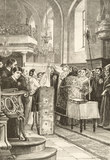In 1910 the Serbs were one of the smaller ethnic groups in the Habsburg Monarchy with around 1.9 million people, 3.8 per cent of the total population. They were scattered throughout several crown lands and regions and did not enjoy an absolute majority anywhere.
There were 640,000 Serbs living in Hungary, accounting for 2.5 per cent of the population of the kingdom. The main concentration of Serbs was to be found in the Serbian Voivodeship (Vojvodina), as it was called, in southern Hungary.
The Serbs made up 24.6 per cent of the population of Croatia-Slavonia. They lived above all in Syrmia in the east of Slavonia, but also in parts of Croatia belonging at the time to the former Military Frontier.
There were a further 100,000 Serbs in the crown land of Dalmatia in Cisleithania. Here, however, no distinction was made in the official statistics between Serbs and Croats, but it is possible to determine numbers on the basis of religion, assuming that the orthodox Christians were likely to be Serb.
In Bosnia and Herzegovina, the most recent territorial addition to the Dual Monarchy, there were 800,000 Serbs, or 43.5 per cent of the population, making them the largest ethnic group.
This extreme dispersion is due to the historical development of the region during the Turkish wars. With the exception of Bosnia, the presence of Serbs in the Dual Monarchy was the result of more recent migratory movements, as the Habsburg Monarchy was seen as a safe haven in the struggle against the Ottoman Empire. A steady flow of refugees streamed north from the sixteenth century onwards. The Serb migration reached a highpoint in the late seventeenth century after an uprising against the Turkish rulers in the Serbian hinterland following the successes of the Habsburgs in the reconquest of Hungary. With the defeat of the uprising in 1690, there was a mass exodus, with the refugees being settled systematically in the area of the Military Frontier in Croatia, eastern Slavonia, southern Hungary and the Banat.
Under the Habsburg rulers, the Serbs were able to maintain their national identity through their membership of the orthodox Church. As the nobility had been destroyed by the Ottomans in the Turkish part or Magyarized in the Hungarian territories, the wealthy Serb bourgeoisie made up of merchants along the Danube and cattle traders provided the backbone of Serbia’s aspirations to nationhood. Serb communities were to be found along the Danube as far as Vienna, with historical centres in Neusatz [Novi Sad] and Karlowitz [Sremski Karlovci]. Serbian commercial dynasties dominated Balkan trade and formed a bridge between the Habsburg Monarchy and the Ottoman Empire, under whose rule the Serbian heartland was to remain until the nineteenth century.
Translation: Nick Somers
Djordjević, Dimitri: Die Serben, in: Wandruszka, Adam/Urbanitsch, Peter (Hrsg.): Die Habsburgermonarchie 1848–1918, Band III: Die Völker des Reiches, Wien 1980, Teilband 1, 734–774
Hösch, Edgar: Geschichte der Balkanländer. Von der Frühzeit bis zur Gegenwart, München 1999
Rumpler, Helmut: Eine Chance für Mitteleuropa. Bürgerliche Emanzipation und Staatsverfall in der Habsburgermonarchie [Österreichische Geschichte 1804–1914, hrsg. von Herwig Wolfram], Wien 2005
-
Chapters
- The Croats in the Habsburg Monarchy
- ‘Loyal rebels: the role of the Croats in the 1848 revolution
- The question of autonomy: the Croats caught between Vienna and Budapest
- The Serbs in the Habsburg Monarchy
- ‘Serbs all and everywhere’: the Serb national programme
- The Bosnians in the Habsburg Monarchy
- Sharia under the Double Eagle: Austria-Hungary and the Bosnian Muslims
- From Illyrism to Yugoslavism: competing concepts for a southern Slav nation
- Friend or foe? The positions of the southern Slavs in the First World War



